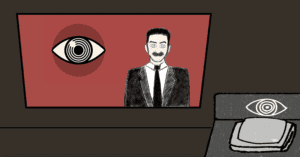Concept
The topic we choose to address is based on the book 1984 written by George Orwell. The book describes a dystopia where the government closely monitors their people and controls both their actions and minds. Our project will present three of the main scenes in the book: the living space, the working space, and the torture chamber – Room 101. In each scene, the players would be like the character Winston Smith in 1984 and play the game in the first person. They can explore the living space and working space. Their choices may lead them to Room 101 and go through unpleasant scenes of punishment. They can be obedient to the Big Brother or they can revolt with their not-cooperating actions, but there is actually no way out in that awful society. We would like to evoke emotions and cause people to think about their freedom and independence, the relation between society and individuals, or other creative thoughts through our dark project. Also, the project will be easily accessible to the audience who have never read the book.
Sources
There are three sources which we chose as inspirations to our project. As stated as our subject for the project, we clearly took our scenes and settings from the book 1984 by George Orwell. The other two inspirations are from two artists. The first one is Angela Washko’s net art “The Game: The Game”, in which she created an interactive game to show the hook-up and dating culture we have become familiar. In our project, we will make an interactive game similar to the process of Washko’s work. The second artist we took inspirations from is Olia Lialina who created one of the masterpieces of net art in the late 1990s. Her work “My Boyfriend Came Back From the War” inspired us from the way it separated different thinkings as if the boyfriend suffered from PTSD. In our project, we will also create an option for the players to select which will be called “doublethink” as written in 1984, which the player will be allowed to think differently than how he or she acts.
Production
In this project, we will incorporate animations, audio, and interactive choices. The rooms will be in animated formats. Before each choice, there will be audio alerts playing, like in “The Game: The Game” designed by Angela Washko, to command the player. In the living space, there will be a big screen for the audience to interact with. The players will be asked to stare at the screen all the time, which means they need to keep putting their mouse on the screen. If they failed, they will be sent to Room 101 to be punished. In the workplace, there will be brainwashing audio playing constantly. The players will be required to ask questions like “Do you believe the Big Brother?”. If they choose the wrong answer, they will end up in Room 101 again. Another setting in the working place is that there will be colleagues there. The player is not alone but in a group of people who are acting obediently to the authority. We want to use the conformity to add pressure on our audience – to stay thinking independently and keep one’s own personality is more difficult when you are in the group. In Room 101, there will be punishment scenes. The game is an endless loop. It will never end because it is life in 1984. After being punished, the players will be sent back to their living/working place and continue their experience. We will set an ending button that always displays on the screen. The players can click on that button and leave the game whenever they want, in case they feel uncomfortable in the game. Although these settings are dark, we are trying to create the best simulation net art for the players. Also, at the beginning of our project, there will be a warning site to suggest that this website is dark and might evoke feelings of uncomfortable.
